Lemon Soap Recipe
A balanced bar with lemon zest and nourishing shea butter. A beautiful hand or shower soap.
Equipment
- safety equipment (goggles, gloves, mask)
Ingredients
- 4.27 ounces lye
- 9.5 ounces water
- 11 ounces olive oil
- 11 ounces coconut oil
- 6 ounces shea butter
- 2 ounces castor oil
- 2 teaspoons grated lemon zest divided
- 0.4 ounces sodium lactate
- 3 tablespoons fragrance oil or lemon essential oil optional
Instructions
- Make the lye water. Measure out the lye and the water in separate, non-reactive containers, using a digital scale. Combine the lye and the water and stir until dissolved. The lye solution will heat up as the result of a chemical reaction. Be careful of fumes, heat, and the corrosive solution. Set the cup aside to cool in a very safe place.
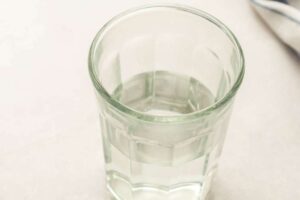
- Heat the oils. Measure out the oils in separate containers and place them in a pot. Add 1 teaspoon of the lemon zest. Melt over medium low heat until fully melted and about 130-140 degrees. Remove from the heat and set aside to cool.
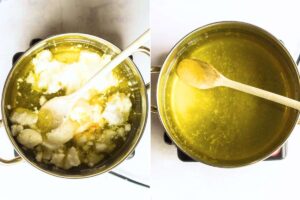
- Prep for blending. Check the temperature of both solutions after an hour or so. Before proceeding, they should be around 90-100 degrees. It is best if they are within ten degrees of each other. Add the sodium lactate to the cooled lye water. Before blending, have your soap mold, last teaspoon of lemon zest, and fragrance ready. Put on gloves and googles.
- Blend to trace. Pour the lye solution into the melted oils and blend with a stick blender until you reach trace. Trace is reached when the soap forms a batter and the stick blender leaves a trail when dragged across the top of the pot. Once trace is reached, add the fragrance and remaining lemon zest and stir in by hand. Immediately pour the soap batter into the mold. Place in a turned off oven or other draft-free place and allow to set for 24 hours.
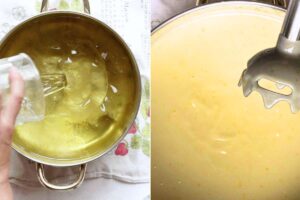
- Pour into mold. Immediately pour the soap batter into the mold. Place in a turned off oven or other draft-free place and allow to set for 24 hours.
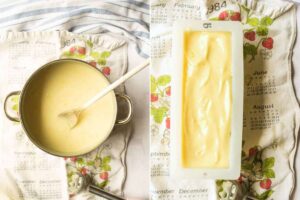
- Cure. Turn out the loaf of soap and slice into bars. Allow to bars to cure in a well-ventilated space for at least 2 weeks before using. Since this soap has a high percentage of olive oil, it will last longer if allowed to cure for 4 weeks.
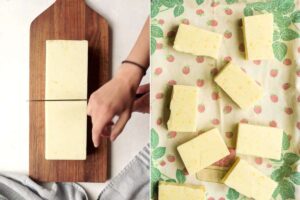
Video
Notes
Be sure to observe all soap safety precautions! Always work in a well ventilated space, free of distractions. Wear eye protection, gloves, and long sleeves. Lye water and raw soap batter are both extremely corrosive and can be fatal if consumed, cause blindness if splashed in the eyes, and will ruin clothing and kitchen surfaces.
To resize this recipe using a soap calculator, here are the percentages you will need: coconut oil 36.67%, olive oil 36.67%, shea butter 20%, castor oil 6.67%. 6% super fat
Servings: 3 pounds soap